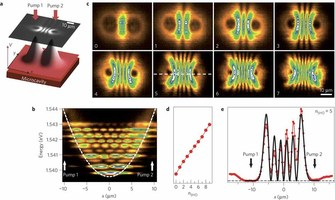
Seeing macroscopic quantum states directly remains an elusive goal.
Particles with boson symmetry can condense into quantum fluids,
producing rich physical phenomena as well as proven potential
for interferometric devices. However, direct imaging of such quantum
states is only fleetingly possible in high-vacuum ultracold atomic
condensates, and not in superconductors. Recent condensation of
solid-state polariton quasiparticles, built from mixing semiconductor
excitons with microcavity photons, offers monolithic devices capable
of supporting room-temperature quantum states that exhibit superfluid
behaviour. Here we use microcavities on a semiconductor chip supporting
two-dimensional polariton condensates to directly visualize the formation
of a spontaneously oscillating quantum fluid. This system is created
on the fly by injecting polaritons at two or more spatially separated
pump spots. Although oscillating at tunable THz frequencies, a simple
optical microscope can be used to directly image their stable
archetypal quantum oscillator wavefunctions in real space.
The self-repulsion of polaritons provides a solid-state quasiparticle
that is so nonlinear as to modify its own potential.
Interference in time and space reveals the condensate wavepackets arise
from non-equilibrium solitons. Control of such polariton-condensate
wavepackets demonstrates great potential for integrated
semiconductor-based condensate devices.
From: G. Tosi, G. Christmann, N. G. Berloff, P. Tsotsis, T. Gao,
Z. Hatzopoulos, P. G. Savvidis, J. J. Baumberg,
“Sculpting oscillators with light within a nonlinear quantum fluid”
Nature Physics,
8, 190-194 (2012).

